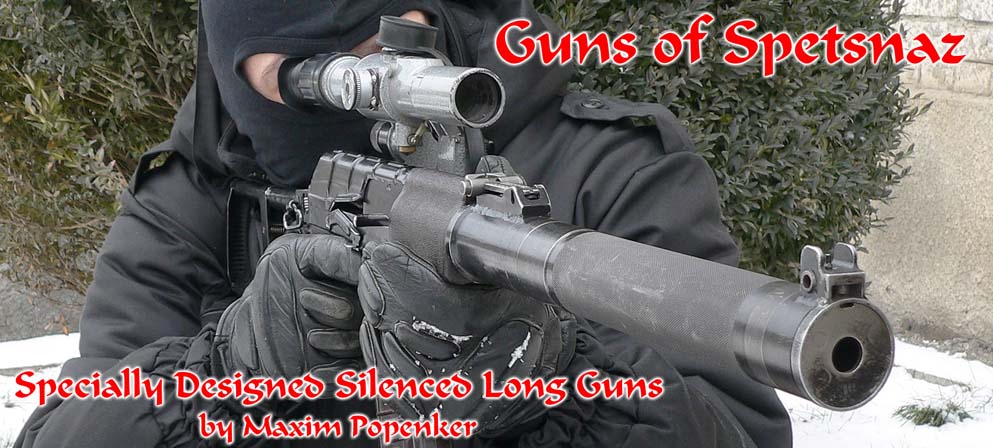OMON (Russian Police Spetsnaz) operator with the AS rifle fitted with PSO-1-1 scope.
As discussed in previous articles on the subject, Soviet Army Spetsnaz troops and specialized KGB personnel (which acted both in and out of country) possessed a significant arsenal of silenced and noiseless handguns. The nature of the Spetsnaz operations, however, was much broader and often required the engagement of targets at longer ranges without attracting undue attention. The simplest and earliest approach was tried during World War II, when NKVD and Army recon units were issued with the so called “Bramit device” – a clip-on silencer for a Mosin-Nagant M1891/30 rifle, developed shortly before the war by the Mitin brothers. This was a more or less conventional expansion type silencer with two rubber baffles. It was to be used only with a special reduced charge 7.62x54R ammunition, loaded with standard “L” type ball bullet and about 1/3 of the standard powder charge. Rifles equipped with Bramit silencers were used throughout the war to good effect behind German lines, taking out sentries, guard dogs and other obstacles.

After the war the Soviet Army changed its main rifle from the long and powerful but slow-firing bolt-action rifle to the much more compact and somewhat less powerful (in terms of bullet energy, not firepower) assault rifles. During the late 1950s Soviet designers developed the first quick-detachable silencer for the Kalashnikov AK assault rifle. Known as the PBS (Pribor dlya Beshumnoj Strelby – device for noiseless firing), this device had a cylindrical body made of two halves, like a clam-shell, with the hinge at the front of the cylinder. Inside it had 12 baffles, machined integral to the semi-cylindrical walls of each half of the device. The halves were held together at the rear by the screw-on end-cap, which also had an interface (threads) for the rifle barrel. The device was also fitted with an additional rubber baffle, which was used to increase barrel pressure during the discharge and thus ensure reliable gas operation with reduced subsonic loads.
During the early 1960s this design was improved – the silencer body was made as a hollow steel cylinder, closed at the front, and the baffles were made as separate units, inserted from the rear and held inside by the screw-on end cap. The rubber baffle (which has a service life of about 200 rounds) was retained. These silencers were to be used only with “US” type reduced charge ammunition, which fired a specially designed bullet of increased weight at subsonic velocities. The typical 7.62×39 “US” round was loaded with a bullet weighing 12.5 grams (193 grains), propelled to a muzzle velocity of about 270-290 m/s (885-950 fps). As time passed, the nature of typical targets and the potential operation profiles for Spetsnaz troops changed.
For one, the NATO forces began to issue body armor on increased scales, and the basic combination of the AKM + PBS + US ammo was no longer effective enough. As a result, during the late 1970s an R&D program for new Spetsnaz long arm was ordered. The task was handed over to the Central Institute of the Precision Machine building (TsNII TochMash), which was responsible for most of the developments in the field of special purpose small arms and ammunition in the USSR. By 1983 the two prime customers for the proposed weapons, the GRU (Army Intelligence Department) and KGB finally agreed on a set of technical requirements for a new silenced sniper rifle. The new R&D program was named “Vintorez” (“thread cutter,” as usual, the name has no practical meaning).
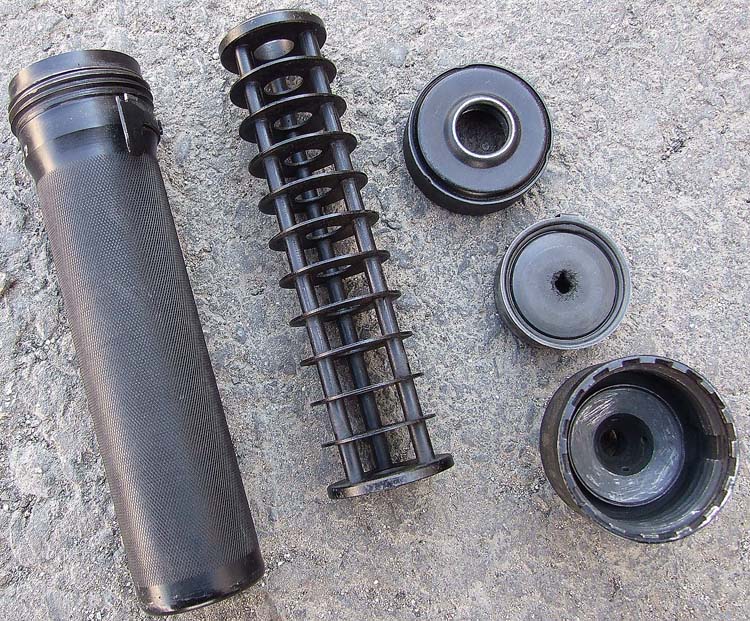
According to the specification, the new weapon was to be effective against enemy personnel at ranges of up to 400 meters. It also had to reliably penetrate a typical steel helmet at the same range. Live fire trials proved that the readily available 7.62×39 US ammo was not up to the task, and new ammunition had to be developed. Several approaches were tried, including combinations of the 7.62×25 TT case and 7.62 7N1 bullet (a sniper-grade bullet for the 7.62x54R cartridge). This ‘Frankenstein’ round was accurate enough, but lacked the necessary penetration and was soon abandoned. A shortened (to 28mm) and necked up 5.45×39 case combined with specially designed 7.62mm AP bullet was tried next. This round showed much potential, but a change in requirements, which happened in 1985, effectively killed it. The reason for this was that the GRU and KGB now also requested a silenced assault rifle, firing the same type of subsonic ammunition, but capable of penetrating military-grade body armor (with steel or titanium armor plates). After examination of the updated requirements the developers decided to create a completely new family of rounds, capable of the necessary accuracy, range and penetration while maintaining subsonic muzzle velocities.
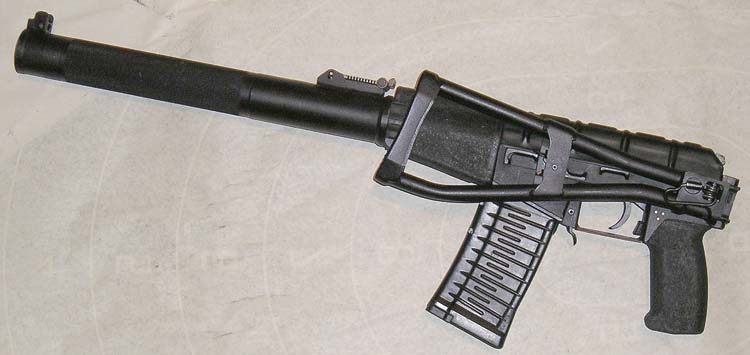
The new ammunition was based on the readily available 7.62×39 M43 steel case, necked up to 9mm and loaded with long and heavy bullets. For sniper work, the developers created the standard steel/lead core jacketed ball bullet. For assault work they also created a special AP round with a hardened steel core that projected forward from the jacket. Upon impacting armor plate, the bullet jacket is stripped off and the penetrator is then free to punch a neat hole through the plate, the underlying Kevlar and the poor guy who happened to cross the path of the Spetsnaz operator. The sniper ball round was designated 9×39 SP-5, and the assault/AP round the 9×39 SP-6. With ammunition now available, the designers quickly finalized the design of the sniper rifle, which was officially adopted by the Army and KGB in 1987 as the 9mm Vintovka Snayperskay Specialnaya VSS – 9mm Special Sniper Rifle.
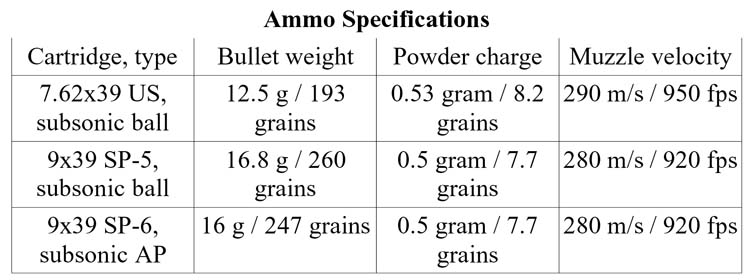
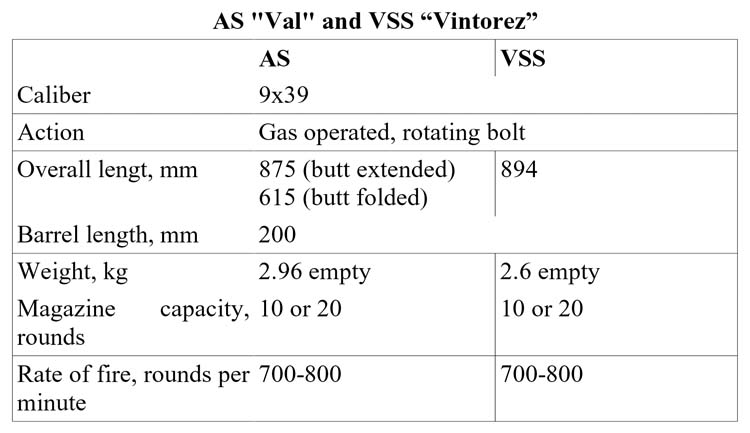
This rifle was quite unusual by typical western standards for a sniper rifle. It was not only semiautomatic, but actually a select-fire weapon, issued with 10- and 20-round magazines. Noise reduction was achieved by using a fairly conventional silencer, made of steel and integrated into the gun design. The rifle was normally equipped with a 4X PSO-1-1 telescopic sight (the same as used on the Dragunov SVD rifle but with a different reticle, adapted for the 9mm round) or the NSPU-3 night sight. Both sights were installed using a standard side rail on the left side of the receiver. Iron sights were provided in the standard configuration as a back-up measure. The rifle was quite compact, reliable, and accurate enough for its intended purpose, and quickly became very popular among its users. Once the design of the sniper rifle proved itself satisfactory, it was quickly modified into a silenced assault rifle, with a minimum of modifications. The basic gas operated action remained the same, but the wooden skeletonized stock was replaced with a metal side-folding stock, and some minor changes were made to the barrel to better withstand automatic firing (the VSS was to be used in full automatic mode only under emergency conditions).

The new rifle was designated 9mm Avtomat Specialnyj AS (AS Special Automatic rifle), and put into production alongside the VSS at the Tula arms factory. The AS is also often referred in literature as ‘Val’ (“Shaft”), as it was the codename for the project used during its development. Like the VSS, AS became quite popular among its users, and is still widely used by special elements of the Russian army and law enforcement units. The VSS and AS were used during the closing years of the Soviet campaign in Afghanistan, but earned their real fame during several bloody campaigns against separatists, Muslim terrorists and various bandits in Chechnya, a mountainous semi-independent republic within the Russian Federation.
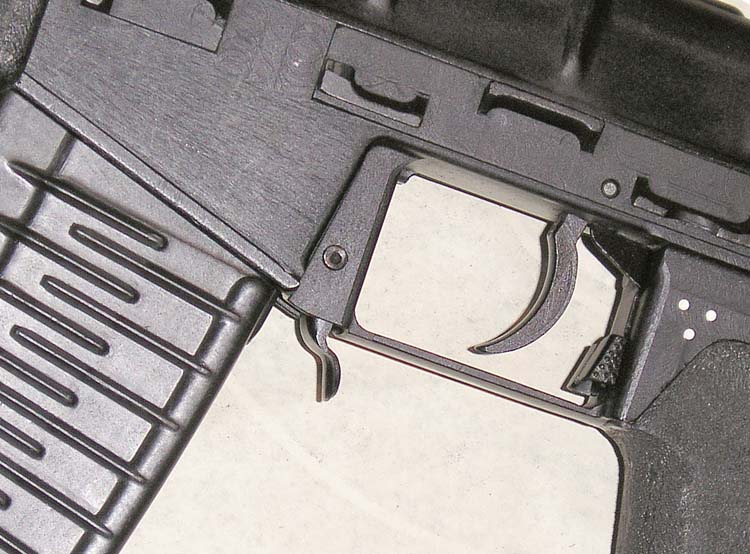
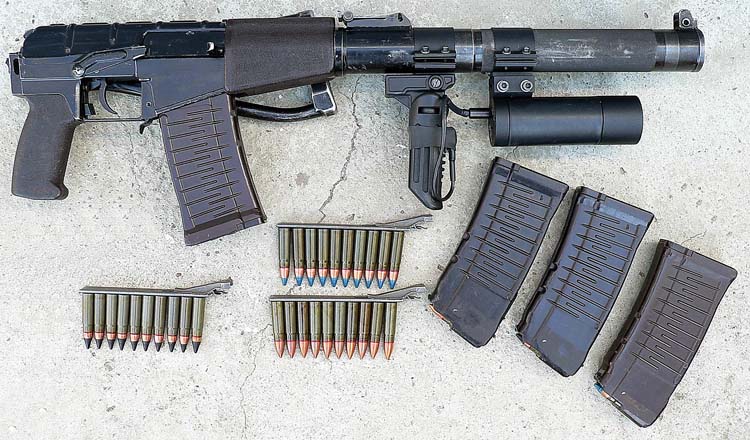
The AS and VSS were prized by both sides for their stealthiness and excellent stopping power, especially when compared with the “tiny” 5.45 bullets fired from standard issue AK-74 assault rifles. The AS became very popular for MOUT operations, especially for house clearing, as it was not so loud as to deafen the operators and their teammates when firing indoors, and was lethal even when firing through barriers and body armor. The opposite side also respected these weapons and paid premium prices for 9×39 guns and ammo on the black market. (Some sources said that one could buy a used car in good shape for the money offered by terrorists for an AS or VSS plus a useable amount of ammunition back in the mid-1990s). These weapons also became quite useful for other police operations, mostly against organized crime such as drug trafficking. The problem was that both the AS and VSS were relatively expensive to produce, and during the turbulent 1990s funds were scarce for many (if not most) law enforcement organizations throughout Russia.
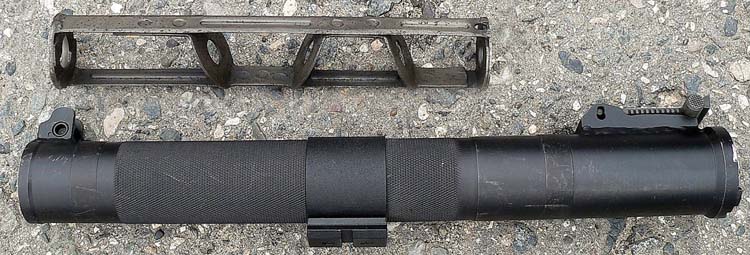
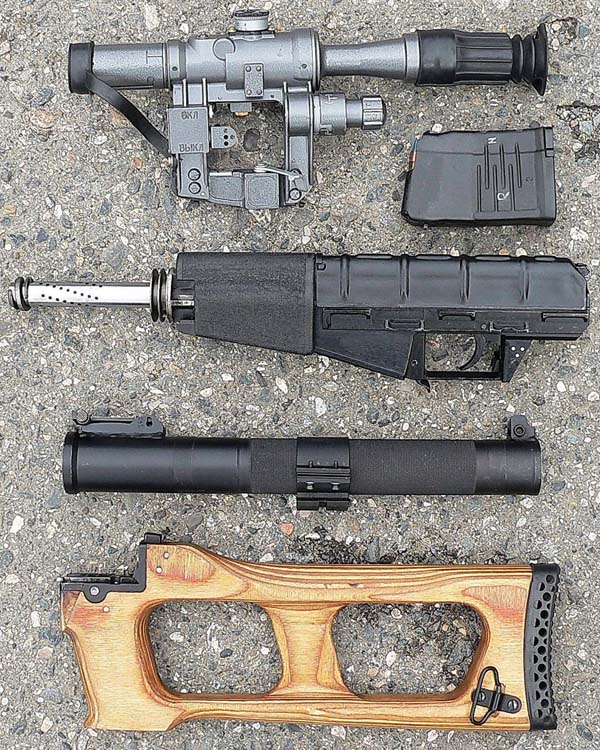
There was the market niche, and there were other organizations willing to fill it and earn some much needed cash to survive the hard times. One such organization was the Central Design Bureau for Sporting and Hunting Arms (TsKIB SOO), located in the city of Tula. During the early 1990s, the design team, lead by V. Telesh, designed two 9×39 weapons, intended for law enforcement use. To ensure a low cost of development and manufacture, both were based on the proven and tried Kalashnikov action, or, to be more precise, on the AKS-74U compact assault rifles, which were manufactured at the Tula Arms factory (TOZ) located nearby. The first of two weapons, known as the OTs-12 “Tiss,” was no more than the standard AKS-74U, rebarreled for the 9×39 ammunition, fitted with a new bolt with an enlarged breech face, and with newly developed 20-round magazines made of steel. The design of the OTs-12 was finalized by 1993, and a pilot batch was manufactured by TsKIB SOO, which had its own small-scale production facility. This pilot batch was distributed to some LE organizations across Russia, but mass production never commenced, and the “Tiss” quickly faded out of sight.
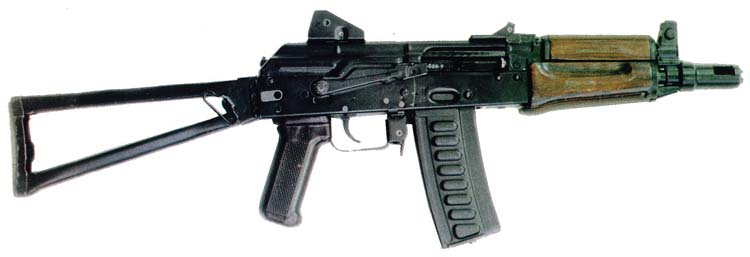
The other weapon from same design bureau earned much more fame, despite the fact that its production life was hardly any more successful. The OTs-14 “Groza” (Thunder) was created as a modular weapon for urban combat and special operations, and was widely publicized in the Russian gun-related press during mid- and late 1990s. The same AKS-74U action adapted for 9×39 ammo (as used in OTs-12), was put into the bullpup configuration to reduce the overall length in the ‘combat’ position. Modularity was achieved by supplying the gun with a detachable 40mm underbarrel grenade launcher firing standard Russian VOG-25 ‘caseless’ FRAG grenades, a quick-detachable silencer, an assault forward grip and a telescopic sight. That allowed the operator to configure his basic weapon according to the upcoming mission profile. Typical configurations were an ‘assault carbine’ with the forward grip, a ‘grenadier’s rifle’ with the underbarrel grenade launcher, a ‘silenced carbine’ with the silencer installed and, finally, a ‘para-sniper’ with a 4X telescopic sight fitted and a silencer where necessary. This sounded very promising but the basic design had some serious issues, some inherent to its parent Kalashnikov-type action, and some not.
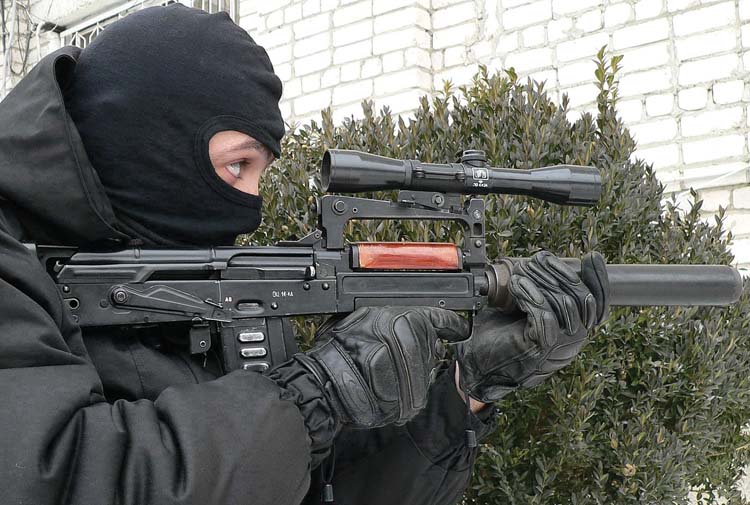
The first issue was that the rifle ejected to the right and it was impossible to fire it from the left shoulder (a feature that can be quite useful during MOUT/CQB operations). Second, all the basic controls (bolt handle and safety/fire selector) remained in their original places on the receiver, way out of reach for the bullpup layout. Third, for some unknown reason, Telesh decided to use a single trigger for both rifle and grenade launcher. In the GL configuration, the user had to switch the single trigger between the rifle and the GL by rotating a lever, located on the left side of the trigger unit, through a 180 degree arc – hardly an intuitive operation, which can take precious seconds during the stress of combat. Nevertheless, TsKIB SOO managed to manufacture several hundred of the OTs-14 rifle kits, and sell these to some LE units and organizations across Russia. Production of the OTs-14 lasted between 1995 and 1998, with several hundreds made, and some OTs-14 rifles still can be found in various law enforcement armories across Russia. It must be noted that today OTs-14 rifles are seldom used in real operations, due to the lack of spares and the overall wear and tear of the guns, without even considering the ergonomic flaws listed above. The AS and VSS rifles, on the other hand, are still in production and in active service with the Russian Army and various law enforcement agencies.
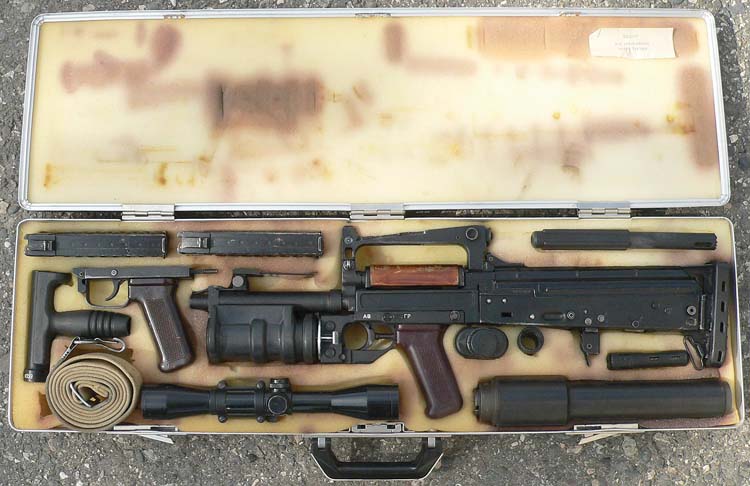
Specifications and technical descriptions
All 9×39 ammunition is loaded into Berdan-primed steel cases with lacquer coating. No headstamps are provided on SP-5 and SP-6 ammunition. SP-5 bullets are fully jacketed, with a tombac-plated steel jacket. The core is of the combination type – the front part of the core is made from steel, the rear part from lead. SP-6 bullets are semi-jacketed with the same tombac-plated steel jacket, but the pointed steel core/penetrator projects from the front of the bullet and the space between the penetrator and the jacket is filled with a thin layer of lead. The penetrator is made from hardened tool-grade steel and usually separates from the jacket when hitting armor plate or other hard barriers: the penetrator goes inside the target while the jacket remains outside of the barrier/armor plate. When hitting soft armor or body tissue, the SP-6 bullet normally stays intact, thus ensuring conformity with international conventions on warfare. Penetration for the SP-6 cartridge is usually listed as 7-8 mm (about 1/3 of an inch) of mild steel at 100 meters, or “guaranteed penetration of Class Three body armor at 400 meters.” The “class 3” body armor, according to Russian standards, ensures protection against all conventional pistol rounds as well as against standard 7.62×39 ball bullets, fired from an AK assault rifle.
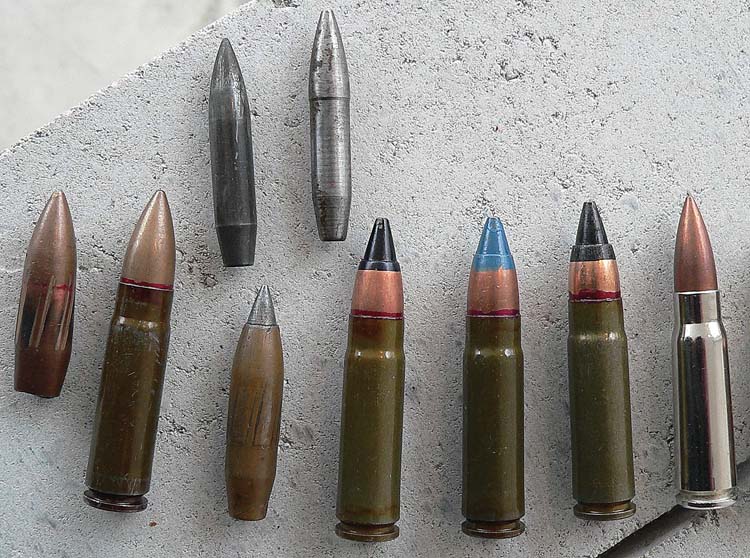
The description below is for the AS “Val” assault rifle. Differences with the VSS are noted where appropriate.
The AS is a gas operated, integrally silenced weapon. The receiver is machined from a steel forging for improved strength and durability. The long stroke gas piston is located above the barrel, and rigidly attached to the bolt carrier. The rotating bolt has six radial lugs and locks into the receiver. The front part of the barrel, ahead of the gas port, has several sets of holes drilled at the bottom of the rifling grooves. These holes are used to bleed some of the gun gas into the integral silencer.
The trigger unit is somewhat similar to that of the Czech-made Sa. Vz.58 assault rifle, and is striker-fired. The striker spring is located below the bolt return spring, and both springs are assembled into the captive unit with spring guides and a polymer bolt buffer attached to the rear plate of the unit. The safety lever is similar to the one found on all Kalashnikov-type rifles, but the fire mode selector is a separate lever located within the trigger guard just behind the trigger. The lever positions are marked with white dots on the pistol grip – three dots on the left side mark the full-automatic setting, and a single dot on the right marks the single-shot mode.
The tangent-type rear sight has a typical U-notch and is graduated up to 400 meters in 25 meter increments, but the actual effective range is about 200-300 meters due to the rainbow-shaped trajectory of the subsonic bullets. It is interesting to note that both rear and front sights are installed on the silencer body rather than on the barrel or on the receiver. The front sight is a protected post that can be adjusted for zeroing. The side rail for day/night scope mounting is machined on the left side of the receiver. The VSS has a slightly different rear sight, which is graduated for SP-5 sniper ball ammunition, with settings between 100 and 420 meters, in tens of meters. Between 100 and 200 meters the sight is graduated in 50-meter increments (“10”, “15” and “20”), but beyond 200 meters the graduations are in 20- and 30-meter increments, that is “22”, “25”, “27”, “30”, “32” and so on until “42”.
The integral silencer is of a conventional expansion type. Its rear part, which is located around the barrel, serves as an expansion chamber and the front part has four baffles made from stamped steel and welded into the single removable unit. The silencer is attached to the gun via the short thread at the front of the barrel and its co-axial alignment with the bore is ensured by the supporting ring installed on the barrel at the front of the handguard. The lock is located at the bottom of the handguard. The silencer is removed from the gun only for maintenance, transportation or storage; firing the gun with the silencer removed is prohibited due to safety and reliability concerns. The service life of the silencer is normally equal to that of the entire gun system.
The furniture of the AS consists of a short polymer fore end, a polymer pistol grip and a side-folding skeletonized shoulder stock, made of steel tubes, with a plastic buttplate. It folds to the left side of the gun and does not interfere with the controls so the AS can be fired with the stock folded. The VSS has a similar fore end, but the Dragunov-type shoulder stock is made from laminated wood and is integral with the pistol grip. It can be detached for transportation and storage, thanks to the dovetailed mount located on the bottom of receiver just behind the trigger guard. Both weapons have standard sling swivels.
The AS is optimized for high performance armor piercing 9x39mm ammunition, designated SP-6, but can also fire “ball” type SP-5 ammunition intended for VSS sniper rifles. The VSS, which is optimized for SP-5 ball ammo, can also fire SP-6 AP ammunition, but it is not normally recommended due to increased wear of the accurized barrel. The AS is usually issued with 20-round double stack, double feed magazines, made from plastic. VSS rifles are usually issued with 10-round plastic magazines of similar design, which are compatible with 20-round magazines.
The AS is most often used with basic iron sights, although some users try and customize their weapons to better suit their preferences and the combat environment. The VSS is usually issued with the 4X PSO-1-1 telescopic sight or with the NSPU-3 IR/night sight, using special quick-detachable mounts, installed on the side rail.
The OTs-12 “Tiss” is similar in design to the Kalashnikov AKS-74U compact assault rifle in all but a few details. The major differences are the bolt face, adapted to the larger cartridge head diameter (as compared with the standard AKS-74U bolt), the new barrel with the muzzle brake/compensator instead of the flash hider, and the new magazine made of stamped steel. The sights are similar in design to the parent weapon but re-calibrated for 9×39 ammunition. The rear flip-up sight has settings for ranges of 100 and 200 meters, due to the limited range of the subsonic ammunition. Despite the fact that the basic ammunition for the OTs-12 is optimized for use with a silencer, no such attachment was ever offered for the OTs-12.
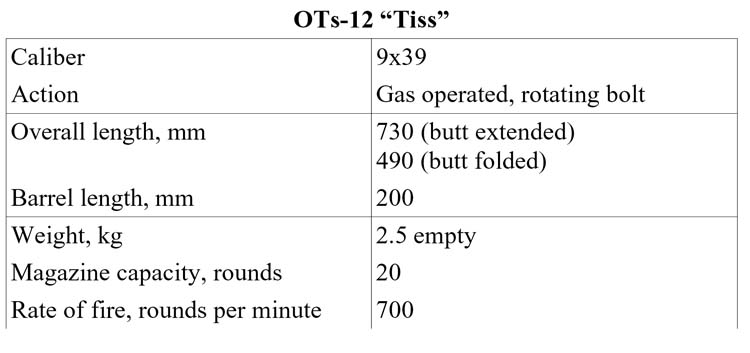
The basic action of the OTs-14 rifle hardly deserves any attention, as it is a direct copy of the standard Kalashnikov AKS-74U action. The receiver, however, is slightly modified and a detachable receiver extension, made of polymer, is added below the barrel in front of the receiver. This extension serves as the base for the installation of the removable pistol grip and trigger unit. The opening at the base of the receiver, which is normally used for the trigger, is protected by a stamped steel cover, pinned in place, and the new, removable forward trigger group is linked to the sear via a push-rod which passes through the forward receiver extension and the bottom of the receiver around the magazine housing. The pistol-grip/trigger unit is locked to its base by a protruding lip at the front and the manually released lock at the rear. The lock is operated by a push-button located on the left side of the pistol grip unit in its rear part. The rifle is normally supplied with two pistol grip/trigger units, one standard and another combined with the grenade launcher. In the latter case, the unit has a large switch on its left side, which selects which barrel to fire – the front position of the switch is for firing the rifle, and the rear for firing the grenade launcher. The manual safety/fire mode selector for the rifle is retained from the parent Kalashnikov design, as well as the reciprocating bolt handle.
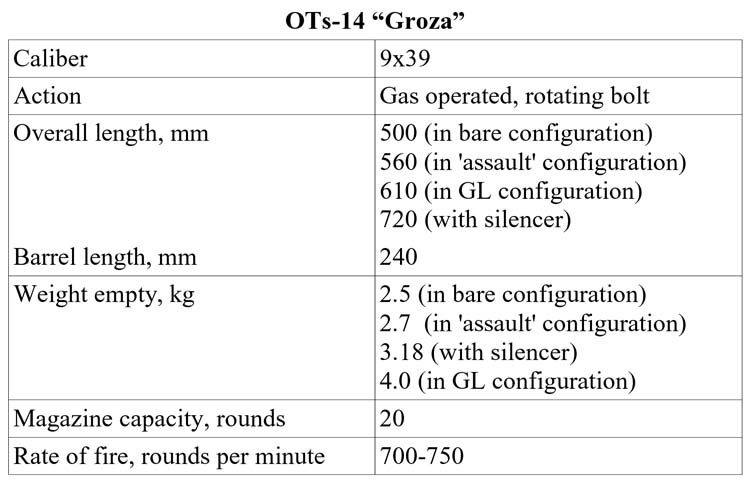
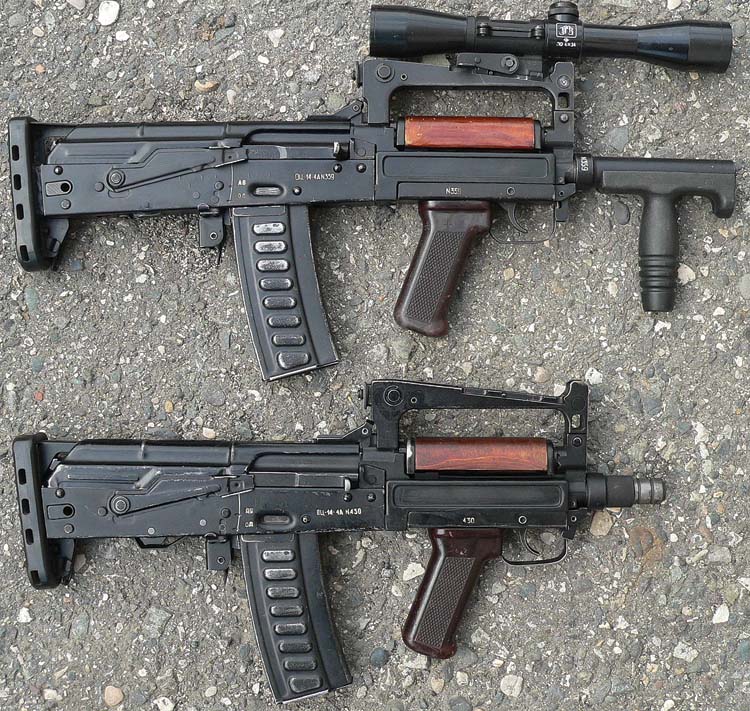
The stock of the weapon consists of a hinged buttplate, attached to the rear of the receiver. It must be unlocked and opened to the left before the gun can be disassembled. In the ‘assault carbine’ configuration the gun is equipped with a forward vertical grip with a tubular barrel extension, which has the purpose of holding the grip and protecting the holding hand from the muzzle blast. The front of the barrel is threaded and, depending on the configuration, accepts the forward assault grip, the detachable silencer or the protective muzzle nut.
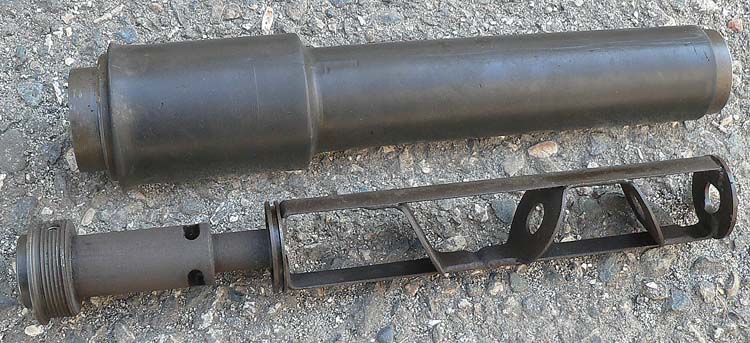
The sights are installed on the short carrying handle, which is made integral to the gun. The rear sight has two alternative openings – a U-notch and an aperture, selectable to the user’s preferences through the 180-degree rotation of the circular rear sight blade. The range adjustment mechanism has four settings – for 50, 100, 150 and 200 meters, with a dial located on the left side of the carrying handle. Zeroing is achieved by adjusting the position of the front sight post. The sight line is quite short, and accuracy with open sights is somewhat limited. The carrying handle is provided with a proprietary quick-detachable mount for a telescopic sight, which is usually a fixed power 4X telescope. In the GL configuration, the barrel extension is fitted with the folding ladder-type grenade sight with range settings between 100 and 400 meters in 50-meter increments.
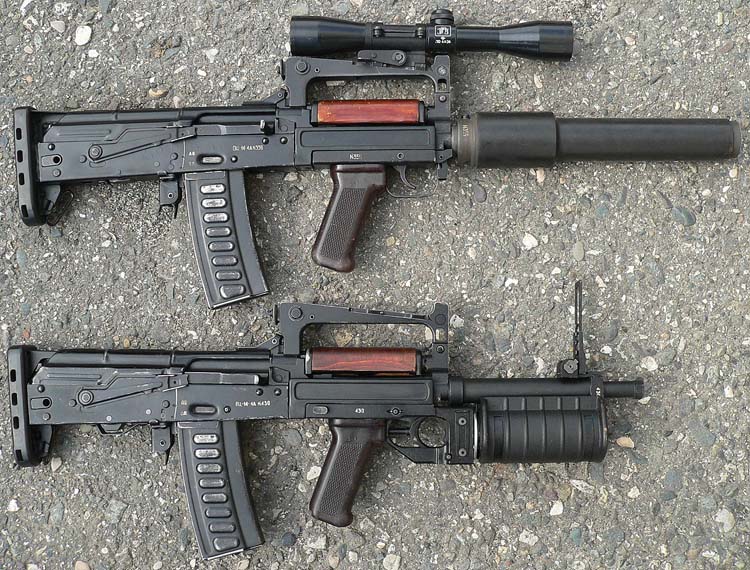
Feed is from detachable box magazines made from stamped steel with a 20-round capacity. Magazines are compatible with those originally made for OTs-12 “Tiss,” but are not compatible with plastic magazines made for the AS and VSS.
The detachable silencer is similar in design to the ones used for the AS and VSS, although the mounting arrangements are different and the barrel of the OTs-14 has no gas escape ports. The silencer body is made of steel with a screw-on end cap at the rear end. The rear part of the silencer, which is of larger diameter, serves as a large expansion chamber. The front part of the silencer contains five baffles, which are made from steel and spot-welded to two side struts to form a single removable unit. Late production silencers had their outer surface covered with a thin layer of rubber to provide some heat insulation and gripping surface.
The OTs-14 weapon was usually shipped in a special fitted case, containing the rifle, two trigger units (one standard and one integral with the grenade launcher), silencer, two magazines, sling, and a detachable forward “assault” grip.
| This article first appeared in Small Arms Review V14N9 (June 2011) |



